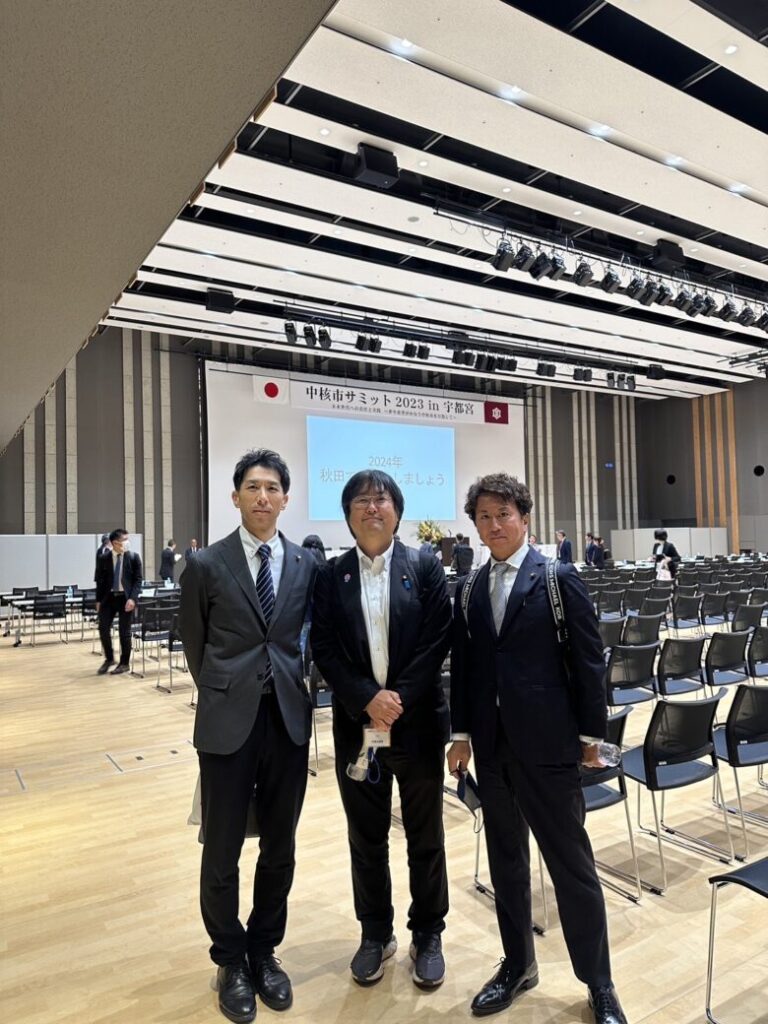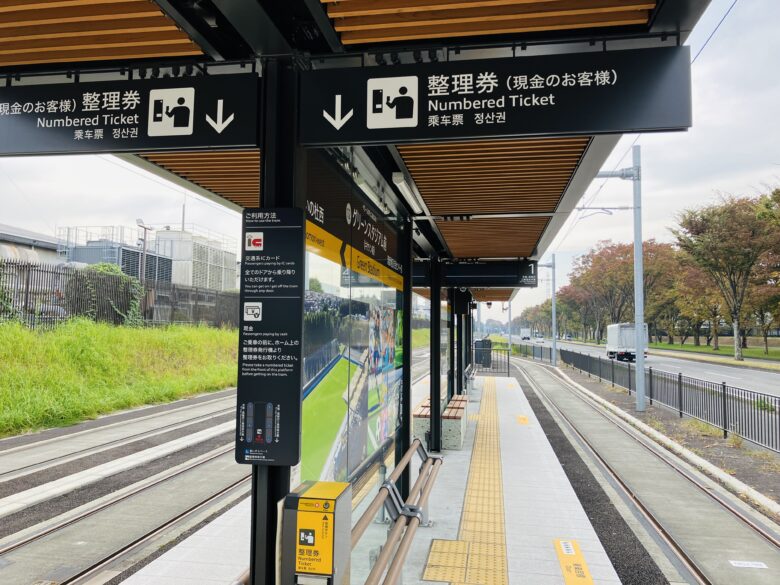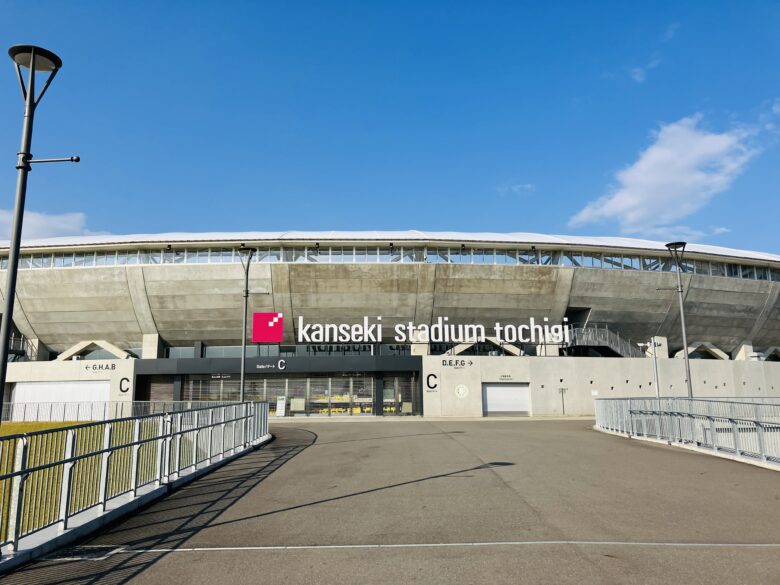宇都宮市で中核市サミットという会議がありましたので、その前後に自分の視察を入れて色々見てきましたので、報告を掲載します。宇都宮市のライトライン(LRT:Light Rail Transit)、栃木県グリーンスタジアム、栃木県総合運動公園陸上競技場(カンセキスタジアム)(いずれも栃木県宇都宮市)を視察してきました。
調査日時:2023年 11月2日(木)9:00~15:00
調査事項:宇都宮市に作られたライトライン(LRT)を利用して、LRTのメリットやデメリットなどを調査した。また、栃木県グリーンスタジアムと栃木県総合運動公園陸上競技場(カンセキスタジアム)の見学によるスタジアムの機能性の比較を調査した。
訪問先:栃木県グリーンスタジアム、栃木県総合運動公園陸上競技場(カンセキスタジアム)(いずれも栃木県宇都宮市)
9:00〜10:00 ライトライン(LRT)乗車
ライトラインは、LRT「Light Rail Transit(ライト レール トランジット)」と呼ばれる一般的な鉄道に比べて、小型で軽量な車両を簡易的な軌道で走行させる軌道系の交通システムのこと。路面を主に走行する点では従来の路面電車(トラムと呼ばれています)と同じだが、大きく改善され速度が速く車内に段差がない低床車両を使い、走行時の騒音や振動が低く快適性に富んでいるのが特徴。 LRTの利点は、地下鉄と違い、建設コストが格段に少なく、開業が極めて早くできること。宇都宮のライトラインは、宇都宮駅から東側に路線が伸びており、工場地帯を抜けて工業団地まで続いている。
10:00〜12:00栃木県グリーンスタジアム視察
対応者:栃木県生活文化スポーツ部スポーツ振興課副主幹 松島靖幸、同主査 小橋 可奈、同主事 長島永人、ALSOK係長 手塚靖
グリーンスタジアムで行われた、事前質問に対しての栃木県庁職員からの説明。(質問と回答)
①カンセキスタジアム(以下カンスタ)とグリーンスタジアム(以下グリスタ)の2つがあり、以下の3つの好条件がグリスタにあるのに、なぜカンスタをホームスタジアムにしたのか?
ア)グリスタにはLRTの駅がある
→LRTによるアクセスはグリスタの方が良い。
イ)グリスタはサッカー専用スタジアムである
→カンスタをメインスタジアムにして、グリスタを補完的に使用しているので、どちらも使用している。メインスタジアムであるカンスタがJリーグの要件を満たしているため、芝の入れ替えなどのメンテナンス作業時に、グリスタを使用して試合を行うことをJリーグに認めてもらっている。
ウ)もし屋根のかける問題があったしたら、グリスタの方が、トラックがない分だけ屋根の総面積が少なくて済んだはずではないか。
→グリスタの屋根のかかっている面積が狭すぎて、屋根をかけるとしたら全て掛け直しする必要があるため、二つのスタジアムでかけなければならない屋根の面積には、さほど差はなかった。またグリスタは屋根替えだけではなく、築30年と言う古い施設であるため、基礎部分など様々な屋根以外の他の箇所の改修工事も同時に必要になるため、予算的なメリットがそこまで大きくなかった。
②カンスタにしたことのメリットは何か(一見グリスタの方がメリットありそうに思える)
→Jリーグの規定を満たしているため、正式な試合ができる点。収容人数がグリスタに比べて1万人増えた点。運動公園内にあるため、収容人数が増えたことと国際大会等を行う規格になったことにより他のスポーツの開催や開会式が可能になった点。
③カンスタにしたことへのサポーターや市民の意見はどうだったか(肯定的なのか否定的なのか)
→市の中心部に住む人からはアクセスが良くなったと言う肯定的な意見は出ている。否定的な意見はあまりないが、グリスタの方が、選手が近くて見やすいという意見は一定数ある。
④メインスタジアムをカンスタにして運用してみて、サポーターや市民からどんな意見が寄せられているか
→雨天時に試合を見やすい。トイレや施設が綺麗。災害等の安全面から、屋根がないグリスタより雷の対応がしやすい。プレーヤーからは更衣室が綺麗、アップ用の屋内天然芝スペースが良いなどの声あり。
⑤カンスタを作って運用してみて、初めて出てきた問題や課題(もしくはメリットもあれば)などはあるか?
メリット:大規模な国際大会を開催することができるようになった。国体等の使用により、認知度が上がった。
デメリット:会場に車で来る人が多いため、複数の大会が重なると、大会時間の前後に周辺道路が渋滞すること。(周辺住民からの苦情も多い)
⑥グリスタをホームスタジアムにした場合、管理者は変わっていたか(今のカンスタの管理者は第3セクターなのか)?
→指定管理制度を通して、第三セクター(財団法人栃木県スポーツ協会と公益財団法人栃木県民公園福祉協会によるコンソーシアム)が管理運営している。
⑦カンスタに屋根をかけた事業は、どこの何の予算を使ったのか(クラブやスポンサーはどのような関わりがあったのか)?
→屋根の架け替えは県単予算。土木工事の一部に国庫補助金を使用したが、屋根の予算は県の単独予算。
⑧カンスタは防災機能を有していると思うが、どのような規模のどのようなものか?
→防災拠点となっており、災害時の備蓄物資の保管施設を兼ね備えている。また今後、防災体験ができる防災教育施設とする案が出ている。
その他の質疑
カンスタを新規で建設するにあたって、県民からのマイナスの感情やご意見はなかったか。
→特になかった。むしろ施設が古くて狭く、施設が大きく綺麗に更新されたことへの県民感情は良いと感じる。
14:00〜15:00 カンセキスタジアム視察
対応者:公益財団法人 栃木県スポーツ協会 総務企画課長 大島政浩
カンスタで行われた施設見学における質疑(質問と回答)
①元から陸上競技施設があったが、なぜそこを改修するなどの方法を取らなかったのか。(運動公園内には、旧陸上競技場は残っている)
→レーンの数やピッチの素材が日本陸連の第3種の認定だったため、新しく大きなスタジアムにして、レーンの数やピッチの素材を日本陸連の第1種の認定を受けられるものにした。(400m×9レーン、ゴム素材のピッチ)
②屋根に関して何か問題はあるか
→完全な屋根ではなく半分空いているので雨は多少入ってくるが、雨天時、利用者の試合観戦は楽になった。屋根の素材が東京ドームの内側と同じ素材であるため、カラスが突っつくと穴が開き、修理が非常に高価であることが悩み。カラスが嫌がる音を出して集まらないような対策をしている。
所感:
<ライトライン>
路線沿いには、高校や大学、大きな工場、それに加えて栃木県グリーンスタジアムというサッカー専用のスタジアムがあり、車を使用しない場合は、とても便利だと感じた。使用されている電車の重量が一般的な電車に比べて軽いというLRTの特徴のため、一般道の跨線橋を一般車両と並走して走ることができ、乗っていてとても興味深かった。宇都宮市は、秋田市と同様に駅の西側に商業地が多く発展しているため、ライトラインを西側に延長することで、宇都宮市が目指している「車が運転できなくても多くの人が市内を移動でき、健康で元気に生活していくための公共交通ネットワークの構築」により近づくのではないかと感じた。東西を繋ぐためには、JR宇都宮駅を跨ぐため、その工事に非常に時間がかかることが想定される。
<栃木県グリーンスタジアム>
非常に古いスタジアムだったが、ピッチの手入れはとても丁寧に行われており、非常に綺麗な芝生であり、長い間大切に使用されてきたことが伺えた。しかし選手控え室やシャワー室などは古く、アップをするための屋内施設はない。また、古い施設によくある車椅子の方や杖をついている方などには使いにくい階段の急傾斜やエレベーターを後付けしたため導線が悪い、トイレの数が少ないなどの問題が多かった。しかし、サッカー専用スタジアムであるため、ピッチと観客席との間には陸上用のトラックがないため、選手と観客の距離が非常に近く、実際の試合は選手の息遣いも聞こえそうでコアなファンが多そうだなと思った。
<カンセキスタジアム>
グリーンスタジアムに比べて、圧倒的に大きく、観客席が多く、綺麗で、障がい者様の席やそこまでの導線も良く、多目的トイレもありトイレ数も十分にあり、またすべての客席に屋根があるため、安心して試合を見ることができる施設だった。また、メディア用の部屋、¬スポンサー用の部屋、VIPルーム(国体が開催されたため天皇陛下をお迎えした)、VIP用の導線(エレベーターや通路)などがきちんと整備されており、さらに、選手目線では広く綺麗な選手控え室や選手関連の施設(シャワー室、アイシング用の部屋、マッサージ部屋、ドーピング検査室、医務室等、アップをするための屋内施設)が整備されていた。国体を開催するため、という名目もあったが、国際大会を開催できるレベルの施設として作られており、中途半端な施設であれもこれもできない、と後から悩むことのない非常に大きく立派な施設だった。
カンセキスタジアムの建設費用は360億円と、秋田市でスタジアムを整備するのには参考にならないほど大きな金額だが、カンセキスタジアム完成後はサッカーや陸上などの大きな国際大会の開催が相次ぎ、選手や観客など関係者による宿泊・飲食等による経済効果は計り知れない。予算を大きくかけないと大きな見返りが見込めない理論はわかるが、財政事情が厳しい秋田市では同規模の予算配分はできないだろう。ただ、トイレの数の多さ、選手目線での使いやすさ、メディアやスポンサー向けの部屋、VIPルームなどは、参考にできると思った。個人的には、スタジアムの屋根のかかった部分の外周を冬にジョギングできるように開放できる作りができないだろうか、という視点で視察ができた。
参考データ:
宇都宮市(栃木県)
人口 51.3万人
面積 1,231平方キロメートル
市議会 45人
令和5年度当初予算総額 3,879億8千万円
(一般会計2,189億8千万円)
















【English】
Survey Date and Time: November 2, 2023 (Thursday) 9:00 AM – 3:00 PM
Survey Topics: Investigation of the Light Rail Transit (LRT) in Utsunomiya City, its advantages and disadvantages, and a comparison of the functionality of the Tochigi Green Stadium and the Tochigi Comprehensive Sports Park Athletics Stadium (Kanseki Stadium).
Visit Locations: Tochigi Green Stadium, Tochigi Comprehensive Sports Park Athletics Stadium (Kanseki Stadium) (Both in Utsunomiya City, Tochigi)
9:00 AM – 10:00 AM: Light Rail Transit (LRT) Ride
The Light Rail Transit (LRT) is a rail transport system that uses small, lightweight vehicles on a simple track system compared to conventional railways. It shares similarities with traditional trams, running mainly on the road. However, LRT improves significantly by using low-floor vehicles without steps, ensuring a quiet and comfortable ride. One notable advantage of LRT is its lower construction cost and faster operational launch compared to subways. Utsunomiya’s LRT extends eastward from Utsunomiya Station, traversing through industrial zones to the industrial park.
10:00 AM – 12:00 PM: Inspection of Tochigi Green Stadium
Attendees: Yasuyuki Matsushima, Deputy Head of the Sports Promotion Section, Culture and Sports Department, Tochigi Prefecture; Kana Kobashi, Chief, Nagashima Eito, Section Chief, ALSOK Department, Yasushi Tezuka
Explanation from Tochigi Prefecture officials in response to pre-prepared questions:
1 Why was Kanseki Stadium chosen as the home stadium, even though Green Stadium has three favorable conditions?
A) Green Stadium has an LRT station, offering better LRT access.
B) Green Stadium is exclusively for soccer.
C) In case of a roof-related issue, wouldn’t Green Stadium need less roof area, considering it doesn’t have a track?
2 What are the merits of choosing Kanseki Stadium (as Green Stadium seems more advantageous)?
・Meets J-League standards, increased seating capacity by 10,000 compared to Green Stadium, located within the sports park, allowing for hosting various sports and opening ceremonies.
3 What were the opinions of supporters and citizens regarding the choice of Kanseki Stadium?
・Positive feedback regarding improved accessibility from the city center; some opinions favoring Green Stadium for closer views of players.
4 What feedback has been received from supporters and citizens after operating Kanseki Stadium as the main stadium?
・Easy viewing during rainy weather, clean facilities, better lightning protection than Green Stadium, positive comments from players on the facilities.
5 Were there any issues or challenges encountered after constructing and operating Kanseki Stadium, or were there any additional merits?
・Merits: Capable of hosting large international events, increased recognition through events like the National Sports Festival.
・Demerits: Traffic congestion during multiple events, especially before and after games, leading to complaints from nearby residents.
6 Has the administrator changed since making Green Stadium the home stadium (Is the current Kanseki Stadium administrator a third sector)?
・Managed through the specified management system by a consortium (consisting of the Tochigi Prefecture Sports Association Foundation and the Tochigi Prefecture Citizens’ Park Welfare Association).
7 For the project of adding a roof to Kanseki Stadium, which budget and source were utilized (What involvement did the club and sponsors have)?
・Roof replacement used the prefectural budget; some national subsidies for civil engineering were applied. The budget solely came from the prefecture.
8 Does Kanseki Stadium have disaster prevention functions, and if so, what scale and features?
・Serves as a disaster prevention center, storing disaster relief supplies. Consideration for transforming it into a disaster education facility in the future.
Other Inquiries:
1 Were there any negative sentiments or opinions from citizens when constructing Kanseki Stadium anew?
・No significant negative feedback. People generally appreciated the updated and larger facilities.
2:00 PM – 3:00 PM: Kanseki Stadium Inspection
Attendee: Masahiro Oshima, Director of the General Affairs Planning Division, Tochigi Prefecture Sports Association Public Interest Foundation
Questions and Answers during the facility tour at Kanseki Stadium:
1 Why not renovate the existing athletics facility instead of constructing a new one (The old athletics stadium remains in the sports park)?
・Due to the third-tier certification by the Japan Association of Athletics Federations for the number of lanes and the pitch material, a new, larger stadium was built to meet first-tier certification standards (400m x 9 lanes, rubber pitch).
2 Are there any issues concerning the roof?
・The roof is not entirely closed, leaving it partially open. Rain can enter to some extent, but it has improved the ease of watching games during rainy weather. Concerns include the cost of repairs if crows peck at the roof, as the material is the same as the inner side of the Tokyo Dome.
The route is convenient, especially considering the presence of high schools, universities, large factories, and the Tochigi Green Stadium along the line. The lightweight nature of LRT vehicles, allowing them to run alongside regular traffic on overpasses, was particularly interesting. Utsunomiya, much like Akita City, has commercial areas developing on the west side of the station. Extending the LRT to the west could contribute to Utsunomiya’s goal of establishing a public transportation network for healthy and active living without the need for driving.
Impressions:
Although an old stadium, the meticulous maintenance of the pitch was evident, showcasing a beautiful lawn that had been cherished for a long time. However, outdated facilities like the player’s waiting room and shower rooms, the absence of indoor facilities for warm-ups, and accessibility issues for individuals with mobility challenges were noted. The absence of a track between the pitch and spectator seats allows for an intimate experience, with fans feeling close to the players during actual matches.
In stark contrast, Kanseki Stadium is impressively large, with numerous spectator seats, clean facilities, excellent accessibility for individuals with disabilities, and ample toilets, including multipurpose ones. The facility is well-maintained and equipped with media rooms, sponsor rooms, a VIP room (used for hosting the Emperor during the National Sports Festival), and VIP pathways (elevators and corridors). The construction cost was significant at 36 billion yen, making it impractical as a reference for Akita City’s stadium development. However, the economic impact from hosting international events, with participants contributing to local accommodation and dining, is immeasurable. The tour raised the question of whether it’s possible to create an open area around the roofed part of the stadium for jogging in winter.
Reference Data:
Utsunomiya City (Tochigi Prefecture)
Population: 513,000
Area: 1,231 square kilometers
City Council: 45 members
Initial budget for FY2023: ¥387.98 billion (General Account: ¥218.98 billion)
【Español】
Fecha y hora de la encuesta: 2 de noviembre de 2023 (jueves) de 9:00 a. m. a 3:00 p. m.
Temas de la encuesta: Investigación del Tránsito Rápido Ligero (LRT) en la ciudad de Utsunomiya, sus ventajas y desventajas, y una comparación de la funcionalidad del Estadio Verde de Tochigi y el Estadio de Atletismo del Parque Deportivo Integral de Tochigi (Estadio Kanseki).
Ubicaciones de visita: Estadio Verde de Tochigi, Estadio de Atletismo del Parque Deportivo Integral de Tochigi (Estadio Kanseki) (Ambos en la ciudad de Utsunomiya, Tochigi)
9:00 a. m. – 10:00 a. m.: Viaje en el Tránsito Rápido Ligero (LRT)
El Tránsito Rápido Ligero (LRT) es un sistema de transporte ferroviario que utiliza vehículos pequeños y livianos en una vía simple en comparación con los ferrocarriles convencionales. Comparte similitudes con los tranvías tradicionales, circulando principalmente en la carretera. Sin embargo, el LRT mejora significativamente al utilizar vehículos de piso bajo sin escalones, asegurando un viaje tranquilo y cómodo. Una ventaja notable del LRT es su menor costo de construcción y un lanzamiento operativo más rápido en comparación con los subterráneos. El LRT de Utsunomiya se extiende hacia el este desde la estación de Utsunomiya, atravesando zonas industriales hasta llegar al parque industrial.
10:00 a. m. – 12:00 p. m.: Inspección del Estadio Verde de Tochigi
Asistentes: Yasuyuki Matsushima, Subjefe de la Sección de Promoción Deportiva, Departamento de Cultura y Deportes, Prefectura de Tochigi; Kana Kobashi, Jefa, Nagashima Eito, Jefe de Sección, Departamento ALSOK, Yasushi Tezuka
Explicación de los funcionarios de la Prefectura de Tochigi en respuesta a preguntas predefinidas:
- ¿Por qué se eligió el Estadio Kanseki como estadio local, incluso cuando el Estadio Verde tiene tres condiciones favorables?
A) El Estadio Verde tiene una estación de LRT, ofreciendo un mejor acceso al LRT.
B) El Estadio Verde es exclusivamente para fútbol.
C) En caso de un problema relacionado con el techo, ¿no necesitaría el Estadio Verde menos área de techo, considerando que no tiene una pista? - ¿Cuáles son los méritos de elegir el Estadio Kanseki (ya que el Estadio Verde parece más ventajoso)?
Cumple con los estándares de la J-League, aumenta la capacidad de asientos en 10,000 en comparación con el Estadio Verde, ubicado dentro del parque deportivo, permitiendo la celebración de varios deportes y ceremonias de apertura. - ¿Cuáles fueron las opiniones de los seguidores y ciudadanos con respecto a la elección del Estadio Kanseki?
Comentarios positivos sobre la mejora de la accesibilidad desde el centro de la ciudad; algunas opiniones a favor del Estadio Verde para obtener vistas más cercanas de los jugadores. - ¿Qué comentarios se han recibido de los seguidores y ciudadanos después de operar el Estadio Kanseki como estadio principal?
Facilita la visualización en días lluviosos, instalaciones limpias, mejor protección contra rayos que el Estadio Verde, comentarios positivos de los jugadores sobre las instalaciones. - ¿Hubo problemas o desafíos después de construir y operar el Estadio Kanseki, o hubo méritos adicionales?
Méritos: Capaz de albergar grandes eventos internacionales, mayor reconocimiento a través de eventos como el Festival Nacional de Deportes.
Desventajas: Congestión del tráfico durante eventos múltiples, especialmente antes y después de los juegos, lo que lleva a quejas de los residentes cercanos. - ¿Ha cambiado el administrador desde que se convirtió al Estadio Verde en el estadio local (¿Es el administrador actual del Estadio Kanseki un tercer sector)?
Administrado a través del sistema de gestión especificado por un consorcio (que consiste en la Fundación de la Asociación Deportiva de la Prefectura de Tochigi y la Asociación de Bienestar del Parque Ciudadano de la Prefectura de Tochigi).
Para el proyecto de agregar un techo al Estadio Kanseki, ¿qué presupuesto y fuente se utilizaron (¿Qué participación tuvieron el club y los patrocinadores)?
La sustitución del techo utilizó el presupuesto de la prefectura; se aplicaron algunas subvenciones nacionales para ingeniería civil. El presupuesto provino únicamente de la prefectura. - ¿Tiene el Estadio Kanseki funciones de prevención de desastres y, de ser así, qué escala y características tiene?
Sirve como centro de prevención de desastres, almacenando suministros de ayuda en caso de desastre. Consideración para convertirlo en un centro de educación para desastres en el futuro.
Otras consultas: - ¿Hubo sentimientos o opiniones negativas de los ciudadanos al construir el Estadio Kanseki de nuevo?
- No hubo comentarios negativos significativos. En general, la gente apreciaba las instalaciones actualizadas y más grandes.
2:00 p. m. – 3:00 p. m.: Inspección del Estadio Kanseki
Asistente: Masahiro Oshima, Director de la División de Planificación de Asuntos Generales, Asociación de Deportes de la Prefectura de Tochigi, Fundación de Interés Público
Preguntas y respuestas durante el recorrido por las instalaciones en el Estadio Kanseki:
- ¿Por qué no renovar la instalación atlética existente en lugar de construir una nueva (el antiguo estadio atlético permanece en el parque deportivo)?
Debido a la certificación de tercer nivel otorgada por la Asociación Japonesa de Federaciones de Atletismo para el número de carriles y el material de la pista, se construyó un nuevo estadio más grande para cumplir con los estándares de certificación de primer nivel (400 m x 9 carriles, pista de goma). - ¿Existen problemas con el techo?
El techo no está completamente cerrado, dejándolo parcialmente abierto. La lluvia puede entrar hasta cierto punto, pero ha mejorado la facilidad de ver juegos durante el clima lluvioso. Las preocupaciones incluyen el costo de reparaciones si los cuervos picotean el techo, ya que el material es el mismo que el lado interno del Tokyo Dome.
La ruta es conveniente, especialmente considerando la presencia de escuelas secundarias, universidades, grandes fábricas y el Estadio Verde de Tochigi a lo largo de la línea. La naturaleza liviana de los vehículos LRT, que les permite circular junto al tráfico regular en los pasos elevados, fue particularmente interesante. Utsunomiya, al igual que la ciudad de Akita, tiene áreas comerciales desarrollándose en el lado oeste de la estación. Extender el LRT hacia el oeste podría contribuir al objetivo de Utsunomiya de establecer una red de transporte público para una vida saludable y activa sin necesidad de conducir.
Impresiones:
Aunque es un estadio antiguo, el mantenimiento meticuloso del campo era evidente, mostrando un césped hermoso que había sido apreciado durante mucho tiempo. Sin embargo, se observaron instalaciones anticuadas como la sala de espera y los vestuarios de los jugadores, la falta de instalaciones cubiertas para calentamientos y problemas de accesibilidad para personas con desafíos de movilidad. La ausencia de una pista entre el campo y los asientos de los espectadores permite una experiencia íntima, con los fanáticos sintiéndose cerca de los jugadores durante los partidos reales.
En marcado contraste, el Estadio Kanseki es impresionantemente grande, con numerosos asientos para espectadores, instalaciones limpias, excelente accesibilidad para personas con discapacidades y amplios baños, incluyendo los de uso múltiple. La instalación está bien mantenida y equipada con salas de medios, salas de patrocinadores, una sala VIP (utilizada para recibir al Emperador durante el Festival Nacional de Deportes) y pasillos VIP (ascensores y corredores). El costo de construcción fue significativo, alcanzando los 36 mil millones de yenes, lo que lo hace impráctico como referencia para el desarrollo del estadio de la ciudad de Akita. Sin embargo, el impacto económico de albergar eventos internacionales, con participantes que contribuyen a la alojamiento y la gastronomía local, es incalculable. El recorrido planteó la pregunta de si es posible crear un área abierta alrededor de la parte cubierta del estadio para correr en invierno.
Datos de referencia:
Ciudad de Utsunomiya (Prefectura de Tochigi)
Población: 513,000
Área: 1,231 kilómetros cuadrados
Concejo Municipal: 45 miembros
Presupuesto inicial para el año fiscal 2023: ¥387.98 mil millones (Cuenta General: ¥218.98 mil millones)

